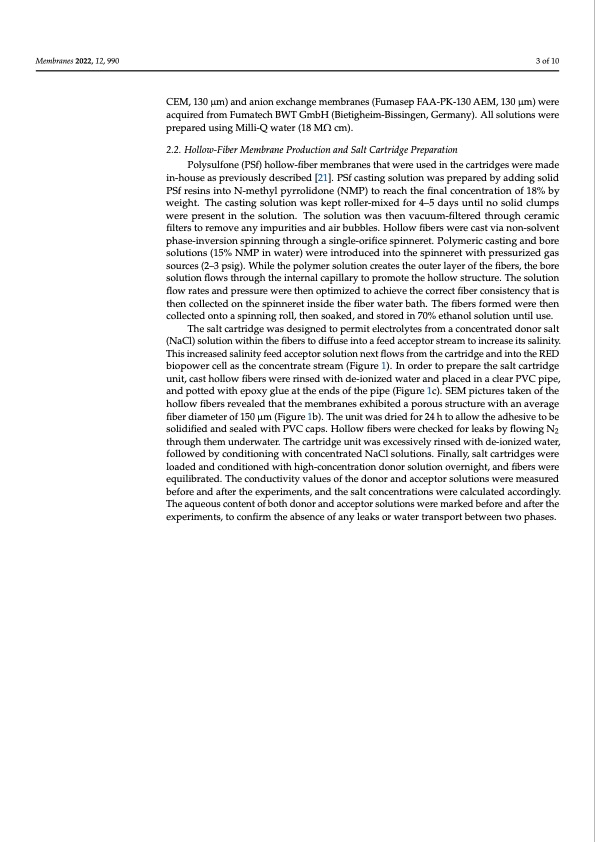
PDF Publication Title:
Text from PDF Page: 003
Membranes 2022, 12, 990 3 of 10 CEM, 130 μm) and anion exchange membranes (Fumasep FAA-PK-130 AEM, 130 μm) were acquired from Fumatech BWT GmbH (Bietigheim-Bissingen, Germany). All solutions were prepared using Milli-Q water (18 MΩ cm). 2.2. Hollow-Fiber Membrane Production and Salt Cartridge Preparation Polysulfone (PSf) hollow-fiber membranes that were used in the cartridges were made in-house as previously described [21]. PSf casting solution was prepared by adding solid PSf resins into N-methyl pyrrolidone (NMP) to reach the final concentration of 18% by weight. The casting solution was kept roller-mixed for 4–5 days until no solid clumps were present in the solution. The solution was then vacuum-filtered through ceramic filters to remove any impurities and air bubbles. Hollow fibers were cast via non-solvent phase-inversion spinning through a single-orifice spinneret. Polymeric casting and bore solutions (15% NMP in water) were introduced into the spinneret with pressurized gas sources (2–3 psig). While the polymer solution creates the outer layer of the fibers, the bore solution flows through the internal capillary to promote the hollow structure. The solution flow rates and pressure were then optimized to achieve the correct fiber consistency that is then collected on the spinneret inside the fiber water bath. The fibers formed were then collected onto a spinning roll, then soaked, and stored in 70% ethanol solution until use. The salt cartridge was designed to permit electrolytes from a concentrated donor salt (NaCl) solution within the fibers to diffuse into a feed acceptor stream to increase its salinity. This increased salinity feed acceptor solution next flows from the cartridge and into the RED biopower cell as the concentrate stream (Figure 1). In order to prepare the salt cartridge unit, cast hollow fibers were rinsed with de-ionized water and placed in a clear PVC pipe, and potted with epoxy glue at the ends of the pipe (Figure 1c). SEM pictures taken of the hollow fibers revealed that the membranes exhibited a porous structure with an average fiber diameter of 150 μm (Figure 1b). The unit was dried for 24 h to allow the adhesive to be solidified and sealed with PVC caps. Hollow fibers were checked for leaks by flowing N2 through them underwater. The cartridge unit was excessively rinsed with de-ionized water, followed by conditioning with concentrated NaCl solutions. Finally, salt cartridges were loaded and conditioned with high-concentration donor solution overnight, and fibers were equilibrated. The conductivity values of the donor and acceptor solutions were measured before and after the experiments, and the salt concentrations were calculated accordingly. The aqueous content of both donor and acceptor solutions were marked before and after the experiments, to confirm the absence of any leaks or water transport between two phases.PDF Image | Integrated Salt Cartridge-Reverse Electrodialysis

PDF Search Title:
Integrated Salt Cartridge-Reverse ElectrodialysisOriginal File Name Searched:
membranes-12-00990.pdfDIY PDF Search: Google It | Yahoo | Bing
Product and Development Focus for Salgenx
Redox Flow Battery Technology: With the advent of the new USA tax credits for producing and selling batteries ($35/kW) we are focussing on a simple flow battery using shipping containers as the modular electrolyte storage units with tax credits up to $140,000 per system. Our main focus is on the salt battery. This battery can be used for both thermal and electrical storage applications. We call it the Cogeneration Battery or Cogen Battery. One project is converting salt (brine) based water conditioners to simultaneously produce power. In addition, there are many opportunities to extract Lithium from brine (salt lakes, groundwater, and producer water).Salt water or brine are huge sources for lithium. Most of the worlds lithium is acquired from a brine source. It's even in seawater in a low concentration. Brine is also a byproduct of huge powerplants, which can now use that as an electrolyte and a huge flow battery (which allows storage at the source).We welcome any business and equipment inquiries, as well as licensing our flow battery manufacturing.| CONTACT TEL: 608-238-6001 Email: greg@salgenx.com | RSS | AMP |